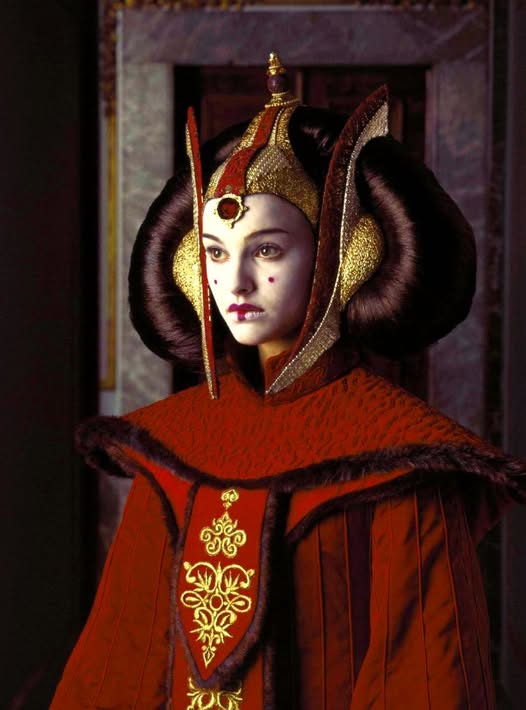When The Phantom Menace debuted in theaters in 1999, most of us were occupied with admiring lightsabers, podracers, and computer-generated extraterrestrials. Upon closer inspection, however, you will discover that Natalie Portman, then seventeen years old, was the galaxy’s most powerful force—not a Jedi. In addition to being remarkable for her age, her work as Queen Padmé Amidala was exceptional overall.
She also demonstrated her strength without having to yell or brandish a saber. We were all led to believe that this teenage queen was capable of ruling a planet when she just developed and delivered her lines with royal accuracy.

A Role That Demanded More Than Talent—It Needed Grit
Think about this: at an age when most of us were fumbling through high school presentations, Natalie Portman was tasked with playing a galactic monarch, a political strategist, and a symbol of resistance. That’s a tall order.
But here’s the thing—she didn’t just deliver lines. She embodied a world-weary ruler with a backbone of steel. From the first moment she appeared on screen in that iconic face paint and elaborate gown, she exuded calm authority. Her performance wasn’t loud or dramatic—it was calculated and composed, like a chess master thinking five moves ahead.
Video: Star Wars Episode I—The Phantom Menace. Freedom of Naboo (Celebration Parade)
Two Characters, One Actress: Pulling Off the Decoy Twist
One of the coolest (and trickiest) plot devices in The Phantom Menace was the identity switch between Padmé and her handmaiden decoy. Most actors struggle to bring one character to life—Portman had to balance two. One minute she was the formal, composed queen; the next, she was the disguised servant, more relaxed but always observant.
What made this duality work was her ability to switch tone, posture, and expression just subtly enough to cue the audience while staying in character. It’s the kind of nuanced acting most people don’t notice—but without it, the whole twist would’ve fallen flat.
Still Waters Run Deep: A Queen Who Doesn’t Need to Scream

Let’s talk about restraint—because Portman made it her superpower. In a movie packed with action scenes and larger-than-life personalities, she played it cool. And that choice made her stand out.
She wasn’t waving a blaster or flipping over droids. She was holding the room with her eyes, navigating negotiations with careful words, and making decisions that carried serious weight. Amidala didn’t need to dominate with volume—she led through wisdom, presence, and a quiet strength that made everyone lean in closer.
Crafting a Queen: From Real-World Royals to Galactic Nobility

Natalie Portman didn’t wing it. Reports suggest she studied real historical figures—queens, diplomats, and female leaders—to shape Padmé’s demeanor. And it shows. Every movement felt deliberate. Her cadence mirrored old-world diplomacy. Even the way she sat—upright, unmoving—projected a kind of old-soul authority rarely seen in teenage performances.
Video: Star Wars Episode I –—Thehantom Menace. Palpatine’s Manipulations
Yes, the costumes helped (and wow, those gowns!). But the clothes alone weren’t what made the queen. Portman gave those gowns their gravitas. She wasn’t just wearing royalty—she was royalty.
When Critics Spoke, They Noticed the Young Queen
Sure, The Phantom Menace got some heat from fans and critics alike. But one thing everyone agreed on? Natalie Portman held her own. She was praised for her poise, her maturity, and her ability to handle some seriously dense political dialogue with total credibility.
This wasn’t a role written for big emotional outbursts or flashy moments. It was all about control, subtlety, and power beneath the surface. And Portman nailed it—so much so that her performance continues to earn fresh praise from new generations discovering the prequels.
Padmé’s Quiet Power Still Echoes in Star Wars Lore
Padmé Amidala didn’t just impact the events of The Phantom Menace—she shaped the entire prequel trilogy. Her moral compass, her dedication to democracy, and yes, her doomed romance with Anakin gave the saga its heart.

Let’s be real: without Padmé, Anakin’s downfall doesn’t hit as hard. Her influence, even after she’s gone, lingers in every choice he makes. She represents what was lost—and Natalie Portman made that loss feel deeply personal.
She Was the Calm in a Storm of Lightsabers
In a universe where battles rage and Sith Lords scheme, it was Natalie Portman’s calm and calculated performance that brought balance. She didn’t need special effects to leave a mark. She used her voice, her posture, and her restraint—and somehow, in the middle of a galactic storm, she made you pay attention to the quiet.
She proved that strength doesn’t always come from shouting louder or fighting harder. Sometimes, it’s found in stillness—in standing your ground with grace when everything else is flying apart.
Conclusion: A Legacy Built on Precision, Not Flash

Natalie Portman’s work in The Phantom Menace is a masterclass in control. At just 17, she stepped into one of cinema’s biggest franchises and left behind one of its most memorable performances—not because she dazzled with spectacle, but because she grounded the story in something real.
She gave us a queen who led with wisdom. A politician who fought with her mind. A heroine whose silence said more than most battle cries. And decades later, her performance still resonates—not because it demanded attention, but because it earned it.
That’s how you command a galaxy—quietly, confidently, and with purpose.




